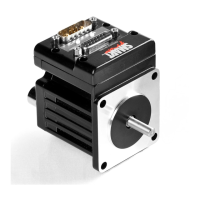Moog Animatics SmartMotor™ Developer's Guide,Rev. L
Page 176 of 909
In addition to the three-axis limitation, keep in mind the overall limit of 64 characters per line
of code in the SmartMotor. Using variables in place of explicit positions is more space
efficient. The PTS() command processes the positions as absolute, whereas the PRTS()
command treats them as relative. After a PTS() or PRTS() command, the combined distance is
stored in the PTSD variable and the combined axis move time is stored in the PTST variable,
in (ms), in the event these may be useful to the programmer. PTSD and PTST can be used in a
program or read over the serial channel by the RPTSD and RPTST commands. The PTS()
command first goes out to the Combitronic network and gathers the last target positions in
order to calculate the relative motion necessary to get to the next absolute position. It is
extremely important that prior to a synchronized move being calculated with the PTS() or
PRTS() commands, the previous target positions are accurate and uncorrupted by origin
shifts. It is equally important that the synchronized move not be initiated before each axis
reaches its previous target positions.
Some gantry-type, multiple-axis machines have two motors operating the same axis of
motion (see the next figure). The following is the full syntax for the PTS command, which
shows additional/optional parameters (enclosed in braces "{}") for support of two motors
operating the same axis. The optional parameter contains the motor address for the second
motor of the axis. (For the PRTScommand, replace PTS with PRTS.)
PTS(pos1;addr1{;addr1'},pos2;addr2{;addr2'}[,pos3;addr3{;axis3'}])
This is illustrated in the following examples. (If you are using the PRTS command, substitute
PRTS in place of PTS below.)
Position target X = 2000
Position target Y = 1000
Position target Z = 500
Motor address X = 5
Motor address X' = 6
Motor address Y = 7
Motor address Z = 8
PTS(2000;5;6,1000;7) 'Two-motor X axis (X, X'), plus Y axis
PTS(2000;5;6,1000;7,500;8) 'Two-motor X axis (X, X'), plus Y & Z axes
In these cases, the same position, velocity and acceleration data sent to motor address 5 is
also sent to motor address 6, with both motors driving the gantry's X axis.
For additional information on the PTS()command, see PTS(...) on page 660. For additional
information on the PRTS()command, see PRTS(...) on page 654. Also, refer to A Note About
PTS and PTSS on page 177.
VTS=formula
Velocity Target for Synchronized Move
The motion along a synchronized move is defined along the path. The VTS command is
specific to defining the combined velocity of all contributing axes. If the move were to occur in
an X-Y plane, for example, the velocity set by VTS would not pertain to the X axis or the Y
axis, but rather to the combined motion, in the direction of motion.
Part 1: Programming: VTS=formula

